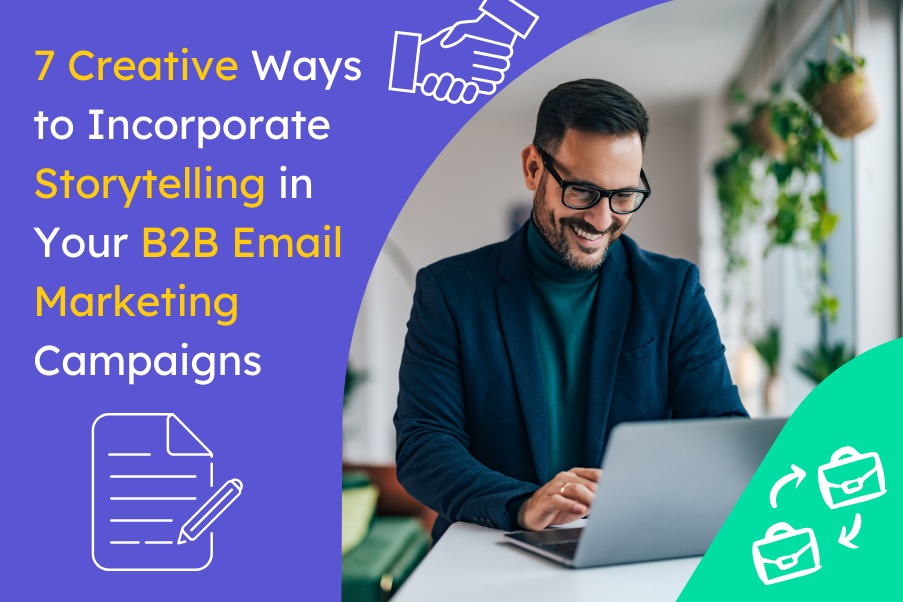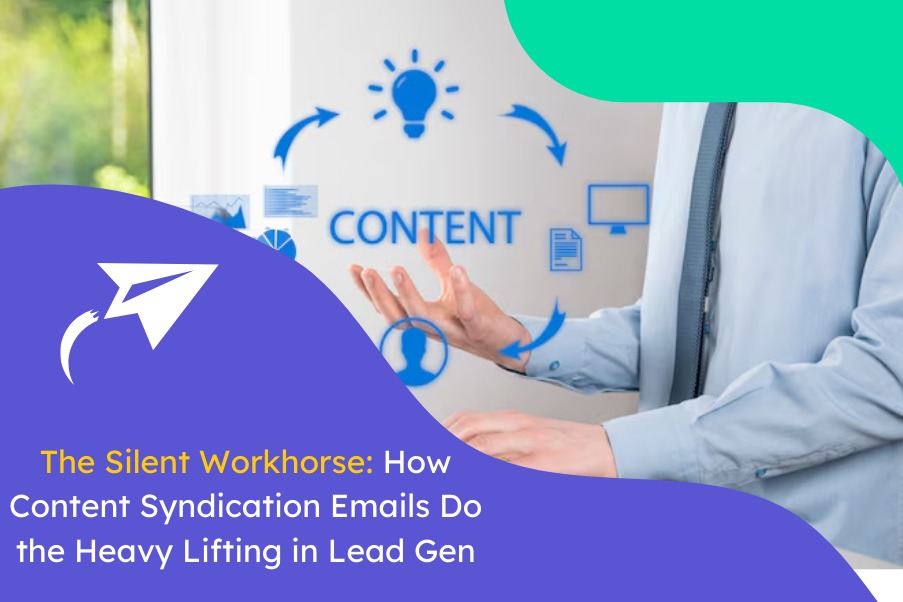7 Creative ways to Incorporate Storytelling in your B2B Email Marketing Campaigns
Capturing your audience’s attention through an email marketing campaign requires more than just promotional messages rather it demands a compelling story. Storytelling is a powerful tool that transforms generic emails into meaningful conversations, making your brand more relatable, engaging, and memorable. Instead of just selling a product or service, you’re inviting your audience into a narrative that resonates with their experiences, challenges, and aspirations.
By weaving storytelling into your b2b email marketing campaigns, you can create deeper connections, build trust, and drive stronger engagement. Let’s explore seven effective ways to infuse storytelling into your email marketing campaign strategy to create messages that truly connect.
What is email marketing campaign?
An email campaign is a series of marketing emails sent to multiple recipients with the goal of driving engagement, sales, or brand awareness. When done right, it helps businesses build trust, keep subscribers engaged, and gather insights to refine future strategies. Email marketing, a powerful promotional tool, is used to inform customers about products, discounts, and services while fostering loyalty. With its effectiveness in driving business growth, email marketing revenue is expected to increase by 287% globally.
7 Ways to Add Storytelling to Your Email Campaigns
Craft Memorable Subject Lines:
Subject lines serve as the gateway to your emails, influencing whether they are opened or ignored. As the first thing recipients see, a well-crafted subject line can set the stage for compelling storytelling. Use curiosity, emotion, or a hint of a story to capture attention and encourage readers to open your email. Think of the subject line as the headline of your story and if it is engaging, it increases the chances of higher open rates and audience engagement.
Start with a welcome message:
As the saying goes, First impressions matter. To make a lasting impact on your customers, a strong introduction is essential in establishing your company. Your welcome email is an opportunity to create a meaningful connection. Instead of a generic introduction, use storytelling to present your brand. Share your company’s origin story or an anecdote about how your product or service was designed to solve a specific problem. Consider including a short video that highlights your mission and showcases what you have to offer. This approach builds trust, fosters a personal connection with new subscribers from the start, and helps them better understand your brand.
Make It Relatable:
Connecting with your audience is crucial, and the best way to achieve this is by sharing stories that feel personal. Use real-world scenarios, challenges, and experiences that resonate with your target audience. Craft emails that address common industry problems in a relatable way and then showcase how your solution has helped other companies to overcome those challenges. Instead of just merely listing features you can illustrate the impact of your product or services on a company’s growth to enhance more understanding.
Maintain Authenticity:
Customers are smart and can easily distinguish between authenticity and deception. They connect with genuine experiences, making authenticity the cornerstone of your B2B email marketing campaign. Share behind-the-scenes insights, challenges your company has faced, and real emotions that make your brand more relatable. Create email campaigns that are transparent, true to your brand identity, and focused on delivering real value to your target audience. By prioritizing honesty, relevance, and human-centric interactions over manipulative tactics, you can foster trust, strengthen connections, and build long-term relationships with potential clients.
Turn Your Customers Stories into Your Own:
Customer reviews play a crucial role in shaping your brand’s reputation. These firsthand experiences help build trust with your target audience. Leverage customer stories through testimonials, case studies, and success stories that showcase how your product or service has made a meaningful impact on their business. A compelling narrative from a satisfied customer enhances credibility and strengthens trust among your audience.
Share your Milestone:
Your achievements are more than just personal milestones rather they are a reflection of your brand’s success and, in many cases, your customers’ accomplishments as well. For example, if your company reaches a significant sales milestone, it highlights the effectiveness and value of your product. Similarly, if a customer achieves a key milestone through their engagement with your brand, sharing their story can celebrate the occasion. These moments also provide an opportunity to engage your audience. Whether it’s a company anniversary, a product launch, or reaching a major goal, storytelling helps make your audience feel like part of your journey. Acknowledge the role your customers have played in your success to make them feel valued and appreciated.
Share Leadership Insights:
Featuring interviews with key people in your company, such as leadership or team members, adds a personal touch and helps showcase your brand’s personality. These interview stories offer a refreshing alternative to traditional marketing emails, allowing readers to connect with the people driving your company’s success. When customers see the faces behind the brand, it humanizes your business beyond just selling products or services. Instead of simply sharing facts or industry trends, present insights in a narrative format to make them more engaging and easier to understand. Personal perspectives shared through interviews help establish authority, provide deeper insights into your brand and products, and make your emails more compelling.
Storytelling isn’t just a creative approach, it’s a strategic advantage in an email marketing campaign. It turns ordinary campaigns into compelling experiences, helping your brand establish authenticity, foster trust, and strengthen customer relationships. By crafting engaging subject lines, sharing personal insights, and celebrating milestones, you create a narrative that resonates with your audience, making them feel valued and connected. As you refine your email marketing campaign strategy, remember that people don’t just buy products rather they invest in brands that tell stories they can relate to. Use storytelling to make your emails more engaging, more personal, and ultimately, more impactful. Start implementing these techniques today, and watch your emails transform into conversations that drive real engagement and long-term loyalty.
Want to get more insights? Contact us at PMG B2B and let’s drive better engagement together!
FAQs
1.How do you create an effective email marketing campaign?
To create a successful email marketing campaign, start by defining your goals and audience. Choose the right email marketing campaign platform, craft compelling content with a strong subject line, and personalize messages to increase engagement. Implement email marketing campaign automation to streamline delivery and optimize timing. Finally, track performance using email marketing campaign analytics to refine your strategy and improve results over time.
2.Can you provide an example of email marketing campaign that drives results?
A drip email marketing campaign for lead nurturing is a great example. It gradually delivers valuable content like case studies, educational resources, and personalized offers based on user interactions to guide prospects through the sales funnel.
3.What are the different email marketing campaigns types ?
Common email marketing campaign types include newsletters, promotional emails, re-engagement campaigns, drip email marketing campaigns, and automated transactional emails. Each serves a unique purpose in customer engagement.
4.How do I set up an effective email marketing campaign?
Start by defining your goal, segmenting your audience, and crafting compelling content. Use an email marketing campaign template for consistency and leverage email marketing campaign automation tools to optimize timing and engagement.
5.How can email marketing campaign analytics improve performance?
Tracking metrics like open rates, click-through rates, and conversions helps refine your strategy. Email marketing campaign analytics provide insights into audience behavior, enabling continuous improvement for better engagement and ROI.
6.How does a drip email marketing campaign enhance customer engagement?
A drip email marketing campaign automates a series of emails sent over time based on user actions, keeping prospects engaged without overwhelming them. By delivering relevant content at the right stage of the customer journey, drip campaigns nurture leads, drive conversions, and improve retention





